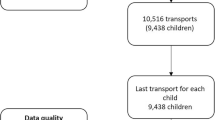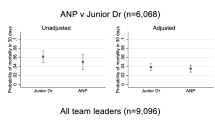Abstract
Objective
To audit paediatric intensive care unit (PICU) transfer activity and transfer-related adverse events in a resource-limited setting.
Design and setting
Twenty-two bed regional PICU of a university children's hospital in Cape Town, South Africa. Prospective 1-year audit of all children transferred directly from other hospitals. Data were collected for patient demographics, diagnostic category, referring hospital, transferring personnel, mode of transport, and technical, clinical, and critical adverse events. Data are median (interquartile range) or percentages. The transfers of 202 children, median age 2.8 months (1.1–14), median weight 3.5 kg (2.5–8.1) were analysed.
Results
Most transfers were performed by paramedic personnel (82%) and via road ambulance (76%). One or more technical adverse events occurred in 36%, clinical adverse events in 27%, and critical adverse events in 9% of children. Retrievals by intensive care staff (10%), all from rural hospitals, had a lower incidence of technical adverse events (0%). Children transferred from non-academic hospitals within the metropolitan area had the highest incidence of technical (44%), clinical (39%), and critical (17%) adverse events. Crude mortality was 17% (n=34). Technical adverse events were not associated with mortality. Non-survivors were more likely to develop shock (32%) or hypoxia (26%) during transfer than survivors (10% and 11%, respectively).
Conclusions
There is a high incidence of transfer-related adverse events, most commonly in transfers from non-academic metropolitan hospitals. Further studies are needed to assess the impact of regional paediatric life support training or a specialised retrieval team on clinical adverse events and mortality.
Similar content being viewed by others
References
Pearson G, Shann F, Barry P, Vyas J, Thomas D, Powell C (1997) Should paediatric intensive care be centralised? Trent versus Victoria. Lancet 349:1213–1217
Henderson AJ, Garland L, Warne S, Bailey L, Weir P, Edees S (2002) Risk adjusted mortality of critical illness in a defined geographical region. Arch Dis Child 86:194–199
Macrae DJ (1994) Paediatric intensive care transport. Arch Dis Child 71:175–178
Mok Q, Tasker R, Macrae D, James I (1996) Impact of specialised paediatric retrieval teams. BMJ 312:119
Bion JF, Wilson IH, Taylor PA (1988) Transporting critically ill patients by ambulance: audit by sickness scoring. BMJ 296:170
Kanter RK, Tompkins JM (1989) Adverse events during interhospital transport: physiologic deterioration associated with pretransport severity of illness. Pediatrics 84:43–48
Barry PW, Ralston C (1994) Adverse events occurring during interhospital transfer of the critically ill. Arch Dis Child 71:8–11
Edge WE, Kanter RK, Weigle CGM, Walsh RF (1994) Reduction of morbidity in interhospital transport by specialized pediatric staff. Crit Care Med 22:1186–1191
Sharples PM, Storey A, Aynsley-Green A, Eyre JA (1990) Avoidable factors contributing to death of children with head injury. BMJ 300:87–91
Britto J, Nadel S, Maconochie I, Levin M, Habibi P (1995) Morbidity and severity of illness during interhospital transfer: impact of a specialised paediatric retrieval team. BMJ 311:836–839
Sajjanhar T, Tibby SM, Hatherill M, Marsh MJ, Murdoch IA (1997) A paediatric retrieval service: its effect on clinical efficacy, activity and resource use in a tertiary paediatric intensive care unit. Clin Intensive Care 8:178–181
Goldhill DR, Withington PS (1998) Tertiary centres are unproved. BMJ 317:1320
Logan S (1995) Commentary: evaluation of specialist paediatric retrieval teams. BMJ 311:839
Goh AY, Abdel-Latif ME, Lum LC, Abu-Bakar MN (2003) Outcome of children with different accessibility to tertiary pediatric intensive care in a developing country—a prospective cohort study. Intensive Care Med 29:97–102
Milne E, Whitty P (1995) Calculation of the need for paediatric intensive care beds. Arch Dis Child 73:505–507
Thomas S, Muheki C, Muirhead D, Doherty J (2000) Briefing summary. Public sector financing. South African Health Review.www.hst.org.za
Shungking M, Giese S, Hendricks M, Irlam J, Abrahams E, Guthrie T, et al (2000) Child health. South African Health Review.www.hst.org.za
Shann F, Pearson G, Slater A, Wilkinson K (1997) Paediatric index of mortality (PIM): a mortality prediction model for children in intensive care. Intensive Care Med 23:201–207
Rapoport J, Teres D, Lemeshow S, Gehlbach S (1994) A method for assessing the clinical performance and cost-effectiveness of intensive care units: a multicenter inception cohort study. Crit Care Med 22:1385–1391
Kanter RK (2002) Regional variation in child mortality at hospitals lacking a pediatric intensive care unit. Crit Care Med 30:94–99
Parry G, Jones S, Simic-Lawson M (2002) Calibration of the paediatric index of mortality in UK paediatric intensive care units. Arch Dis Child 86:65–69
Tibby SM, Murdoch IA (2002) Calibration of the paediatric index of mortality score for UK paediatric intensive care. Arch Dis Child 86:65–69
Booy R, Habibi P, Nadel S, de Munter C, Britto J, Morrison A, Levin M (2001) Reduction in case fatality rate from meningococcal disease associated with improved healthcare delivery. Arch Dis Child 85:386–390
Pearson GA, Stickley J, Shann F (2001) Calibration of the paediatric index of mortality in UK paediatric intensive care units. Arch Dis Child 84:125–128
Shann F (2000) Where do all the children go? Intensive Care Med 26:6–7
Raffles A (1996) Intensive care provided by local hospitals should be improved. BMJ 312:120
Cray SH (1996) London group's findings supported by study in Leeds. BMJ 312:120
Author information
Authors and Affiliations
Corresponding author
Additional information
An editorial regarding this article can be found in the same issue (http://dx.doi.org/10.1007/s00134-003-1890-0)
Electronic Supplementary Material
Rights and permissions
About this article
Cite this article
Hatherill, M., Waggie, Z., Reynolds, L. et al. Transport of critically ill children in a resource-limited setting. Intensive Care Med 29, 1547–1554 (2003). https://doi.org/10.1007/s00134-003-1888-7
Received:
Accepted:
Published:
Issue Date:
DOI: https://doi.org/10.1007/s00134-003-1888-7




